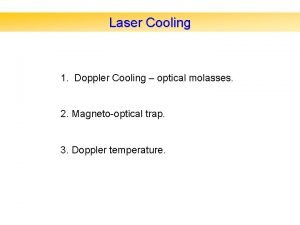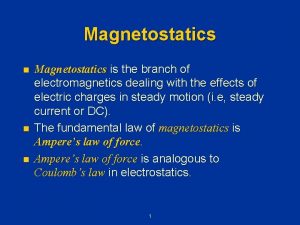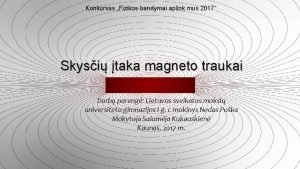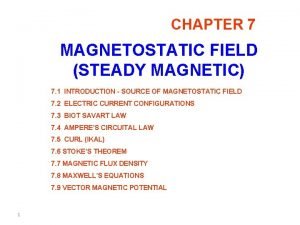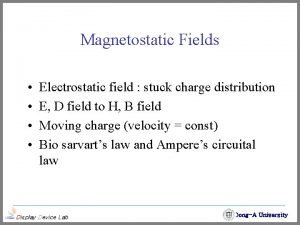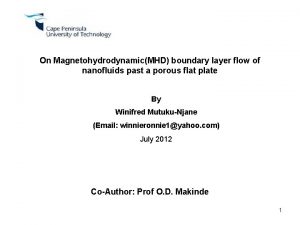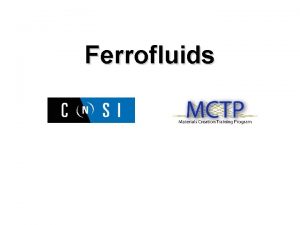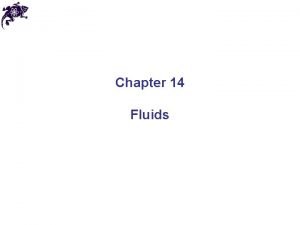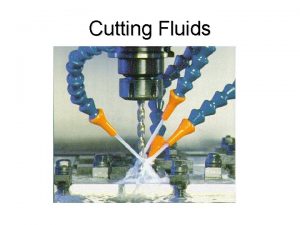Ferrofluids Magneto Rheological MR Fluids http homepages cae









- Slides: 9

Ferrofluids – Magneto. Rheological (MR) Fluids http: //homepages. cae. wisc. edu/~klingen/group/ermrintro. htm Short overview of field of Electrorheological and magnetorheological (ER and MR) fluids. Good ref See Scientific American!! "Making Fluids into Solids with Magnets, " D. J. Klingenberg, Scientific American, 112 -113. October, 1993. [Journal] Apparent suspension viscosities can increase by orders of magnitude for electric fields on the order of 1 k. V/mm for ER fluids, and for flux densities on the order of 1 T for MR fluids. Viscosity data for an MR fluid composed of 10 vol% iron spheres in silicone oil is presented in Figure 1 The applied field causes the particles to aggregate into columnar structures, as illustrated in Figure 2 for a 2 vol% suspension of iron particles in silicone oil (the direction of the external field is indicated by the arrow).

Ferrofluids – Magneto. Rheological (MR) Fluids http: //homepages. cae. wisc. edu/~klingen/group/ermrintro. htm The chart on this webpage was very helpful. For a given shear rate, it appears the viscosity increases only gradually with an increasing magnetic field, and while the jump in viscosity from B = 0 to B ≠ 0 is orders of magnitude, you get several more orders with a lower shear rate. I don’t know much about shear rates, but Wikipedia (http: //en. wikipedia. org/wiki/Shear_rate) claims shear rate = 8 * linear fluid velocity / diameter of the pipe for Newtonian fluids. I believe ferrofluids are non-Newtonian, but I thought perhaps the inverse relationship between shear rate and pipe diameter might still hold. Therefore, it seems if we used a setup with a larger diameter, we might be better able to detect an increase in viscosity from B = 0 to B ≠ 0. Apparent suspension viscosities can increase by orders of magnitude for electric fields on the order of 1 k. V/mm for ER fluids, and for flux densities on the order of 1 T for MR fluids. Viscosity data for an MR fluid composed of 10 vol% iron spheres in silicone oil is presented in Figure 1 The applied field causes the particles to aggregate into columnar structures, as illustrated in Figure 2 for a 2 vol% suspension of iron particles in silicone oil (the direction of the external field is indicated by the arrow).

Ferrofluids – Viscosity “Ferrofluid Flow Phenomena” by Thomas A. Franklin (saved in Ferrofluid folder on JLab drive) This paper did not include any experiments on the relationship between viscosity and B field, but did measure the viscosity of EFH 1 outside a B field. He seemed to have the most luck with EFH 1 with the Brookfield rotating shear viscometer, followed by the Cannon-Fenske Opaque Kinematic Viscometer, which was difficult to clean after the EFH 1 apparently. The issue with using these over the method we have been using would seem to be applying a constant magnetic field, though with a series of magnets placed around them, this could probably be done, and these instruments would almost certainly give us more precise results than what we’ve been using. Generally speaking, kinematic viscosity (c. St) is related to absolute viscosity (c. P) as a function of the fluid’s specific gravity (SG). http: //www. machinerylubrication. com/Read/294/absolute-kinematic-viscosity

Data provided by Ferro. Tec: FERROFLUID TYPE: EFH 1 (nominal values) MEDIUM. . . . . LIGHT MINERAL OIL SATURATION MAGNETIZATION. . . 400 GAUSS INITIAL SUSCEPTIBILITY. . . . . 1. 70 FLASH POINT. . . . 92° C POUR POINT. . . . -94° C VOLATILITY (1 hr. @ 50° C). . . . . 9% DENSITY. . . . 1. 21 gm/ml VISCOSITY. . . 6 cp @ 27°C SURFACE TENSION. . . . . 29 dynes/cm Note that on page 52 of “Ferrofluid Flow Phenomena” (saved in Ferrofluid folder on JLab drive) Thomas A. Franklin claims to have found EFH 1 to have a viscosity of 10. 0 c. P, which he states is slightly outside the range Ferro. Tec provides. The link at the bottom where the page to the left was taken from suggests using reverse flow viscometers for opaque liquids. These are available in sizes 25 – 700. Sample certificates of calibration suggest that size 100 of this sort of viscometer has a “Working diameter of upper reservoir 2. 5 cm for C, 2. 7 cm for D. ” A routine viscometer (not opaque) of size 200 has a “working diameter of lower reservoir” of 3. 0 cm. (See Ferrofluids folder for PDF’s. ) Cannon seems to want to sell you on a size based on the fluid’s viscosity in c. St, which we know for EFH 1 using the conversion on the previous page. SG = 1. 21 g/m. L / (1 kg/m^3) = 1210. c. St = c. P/SG = 6/1210 c. St =. 005 c. St. Viscosity = 6 c. P = y c. St * 1. 21 g / cm^3 / 1 kg * m^3 = 1210 y c. St =. 005 c. P Viscosity =. 03 c. St. Document Title/Description http: //www. docstoc. com/docs/74702630/Kin ematic-Viscosity-Tubes 4

Ferrofluids – Magnetorheological (MR) Fluids http: //www. carbibles. com/suspension_bible_pg 3. html WHAT IS MAGNETORHEOLOGICAL FLUID? Magnetorheological fluid is a suspension of magnetic fractions (reduced iron, pure iron, cobalt, carbonyl iron, nickel) of about 0, 1… 100 micrometers in a liquid carrier. Different liquids can be the liquid carrier, depending on the propose of the device these can be: water, organosilicic (silicone) liquid, synthetic and semi-synthetic oils, mineral oil, etc. Apparent suspension viscosities can increase by orders of magnitude for electric fields on the order of 1 k. V/mm for ER fluids, and for flux densities on the order of 1 T for MR fluids. Viscosity data for an MR fluid composed of 10 vol% iron spheres in silicone oil is presented in Figure 1 Useful site for car suspension etc. Diagram is more useful than I earlier thought. The B fields are transverse to the fluid channels/flow. MOVIES: from http: //mrfengineering. com. ua/magnytoreologycheskaya-zhydkost? lang=en

http: //autospeed. com. au/cms/title_Magnetic. Dampers/A_110995/article. html Very good applied site http: //science. howstuffworks. com/engineeri ng/structural/smart-structure 2. htm MOVIE http: //autospeed. com. au/cms/title_Magnetic. Dampers/A_110995/article. html

MR systems from Max Planck Institute http: //www. mpe. mpg. de/~pbrandt/rheology. html Max Planck Good description of Complex Systems including: E L E C T R O- A ND MAG NE T O R HE O LO G I C AL F L U ID S Mirco- and nano-particles consisting of special materials have a nice feature: Usually those particles just behave like normal (i. e. colloidial) particles. But influenced by an external those particles carry an induced (electric or magnetic) dipole moment. Of course, this moment is also perfectly aligned in the direction of the external field. Thus, if we assume this field is homogenous, all particles carry a moment of the same magnitude which is additionally precisely tunable.

Ferrofluids – Magnetorheological (MR) Fluids Magneto-rheological (MR) fluids respond to a magnetic field with a dramatic change in rheological behavior. These fluids can reversibly and instantaneously change from a free-flowing liquid to a semi-solid with controllable yield strength when exposed to a magnetic field. In the absence of an applied field, MR fluids are reasonably well approximated as Newtonian liquids. For most engineering applications, a simple Bingham plastic model is effective in describing the essential, field-dependent fluid characteristics. A typical MR fluid consists of 20 -40 percent by volume of relatively pure, 3 -10 micron diameter iron particles, suspended in a carrier liquid such as mineral oil, synthetic oil, water or glycol. A variety of proprietary additives, similar to those found in commercial lubricants to discourage gravitational setting and promote particle suspension, are commonly added to LORD Corporation's state-of-the-art MR fluids to enhance lubricity, modify viscosity and inhibit wear. http: //www. archello. com/en/product/mr-fluid More or less the idea I had

How Liquid Body Armor Works http: //science. howstuffworks. com/liquid-body-armor 2. htm oe 5_img 2. jpg bwigroup. com 324 × 171 - When the coil current is off, the MR fluid is not magnetised, …Similar More sizes Presentation by Dr. Matthew Johnson and Michael Wilkinson

